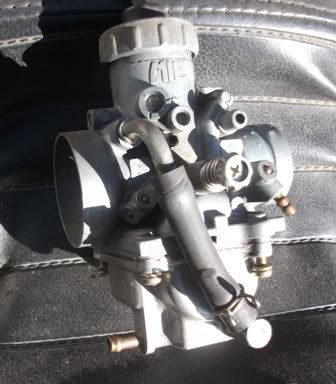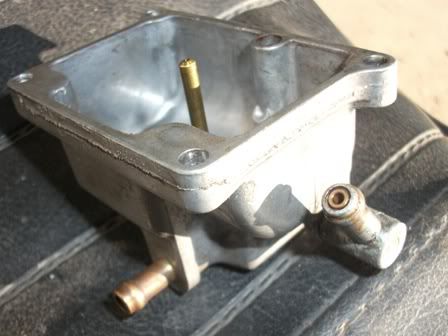A theory
Posted: Mon Dec 05, 2011 2:58 pm
Folks.....I have rebuilt 30 odd RZ 250/350 cranks over the last 20 years, and have just picked up 5 more cranks from a wrecker to rebuild and use as core exchange stock. 
In all cases, except when caused by piston failure..... the left hand big end is the faulty one.
Why is this so?
I have a couple of thoughts, but what do you think?
On the air cooled models, and even on the LC (pre YVPS) this is not as obvious, although I would say that it is still slightly in favour of the L/H being faulty.
A theory....
With regard to the L/H cylinder……. Well I think is has to do with the crank seal behind the Ignition hardening and letting a small air leak happen….. But this is basically identical to the LC’s so why not the same with them?
Well the only other difference (besides the YPVS) is the powerjet carbs….. I thought for a while that cruising just below the Power jet functioning may have been giving a lean running condition and the additional air leak from the seal causing the l/h to run hotter/leaner etc and this may be so, but then when asking a couple of customers what their riding was like just before it happened…..it wasn’t cruising!!!
So I had him bring his carbs in, just out of curiosity and checked out the power jet circuit. Now on the retro fitted powerjet carbs that I had worked on in the past the Power jet is at the end of the fuel supply tube, high up on the back of the carb….. But on the RZ it is located at the bottom of the fuel supply tube, in the bottom (side) of the float bowl…..and it was restricted by gum and muck in the bottom of the float bowl.
So possibly a partially working power jet, combined with a slight air leak is causing this problem…….Maybe? But check those power jets; they are just waiting to be blocked.
What is a powerjet carb
This is an RZ250N powerjet carb....

And this is where the powerjet is located....

The basic principle of operation is:
The remainder of the carb is conventional, and the pilot, cutaway, needle & needle jet and main jet function as normal.
There is a tube from the float bowl to an area where vacuum will exist when the throttle is wide open. In this tube there is a jet, about the size of the pilot jet in the carb, that meters an extra amount of fuel in addition to the main jet at WOT.
This allows you to use a slightly leaner than normal main jet so that the transition (under acceleration) from needle to main mixture is not overly rich, but the correct amount of fuel is then delivered for long periods of WOT.
When these first were developed circa 1972? I was racing a TD3 powered superkart and fitted these as an aftermarket kit that was available at the time (they are still available about $30 a carb).
We found that by adjusting the length/diameter of the hose we could delay the time it took for the power jet to become operational (by a second or two) this gave us an advantage (in a kart) at places like entry to a long sweeper, where the slightly leaner mixture would give a crisper response and better acceleration ....enough to pull alongside a compeditor for the run through the sweeper.....and just before detonation would set in, the powerjet richened it up......
Ahhhhh memories....... I won't tell about the times I got it wrong though.....
Graham
In all cases, except when caused by piston failure..... the left hand big end is the faulty one.
Why is this so?
I have a couple of thoughts, but what do you think?
On the air cooled models, and even on the LC (pre YVPS) this is not as obvious, although I would say that it is still slightly in favour of the L/H being faulty.
A theory....
With regard to the L/H cylinder……. Well I think is has to do with the crank seal behind the Ignition hardening and letting a small air leak happen….. But this is basically identical to the LC’s so why not the same with them?
Well the only other difference (besides the YPVS) is the powerjet carbs….. I thought for a while that cruising just below the Power jet functioning may have been giving a lean running condition and the additional air leak from the seal causing the l/h to run hotter/leaner etc and this may be so, but then when asking a couple of customers what their riding was like just before it happened…..it wasn’t cruising!!!
So I had him bring his carbs in, just out of curiosity and checked out the power jet circuit. Now on the retro fitted powerjet carbs that I had worked on in the past the Power jet is at the end of the fuel supply tube, high up on the back of the carb….. But on the RZ it is located at the bottom of the fuel supply tube, in the bottom (side) of the float bowl…..and it was restricted by gum and muck in the bottom of the float bowl.
So possibly a partially working power jet, combined with a slight air leak is causing this problem…….Maybe? But check those power jets; they are just waiting to be blocked.
What is a powerjet carb
This is an RZ250N powerjet carb....

And this is where the powerjet is located....

The basic principle of operation is:
The remainder of the carb is conventional, and the pilot, cutaway, needle & needle jet and main jet function as normal.
There is a tube from the float bowl to an area where vacuum will exist when the throttle is wide open. In this tube there is a jet, about the size of the pilot jet in the carb, that meters an extra amount of fuel in addition to the main jet at WOT.
This allows you to use a slightly leaner than normal main jet so that the transition (under acceleration) from needle to main mixture is not overly rich, but the correct amount of fuel is then delivered for long periods of WOT.
When these first were developed circa 1972? I was racing a TD3 powered superkart and fitted these as an aftermarket kit that was available at the time (they are still available about $30 a carb).
We found that by adjusting the length/diameter of the hose we could delay the time it took for the power jet to become operational (by a second or two) this gave us an advantage (in a kart) at places like entry to a long sweeper, where the slightly leaner mixture would give a crisper response and better acceleration ....enough to pull alongside a compeditor for the run through the sweeper.....and just before detonation would set in, the powerjet richened it up......
Ahhhhh memories....... I won't tell about the times I got it wrong though.....
Graham